
編者按:日(rì)前,國際電力行業知名刊物《Power》刊登題為“模塊化發電(diàn)廠正在提高肯尼亞地熱效率”的文章,向全球介紹我集團首創的地熱(rè)井口電站(zhàn)技術及(jí)其成就。這是繼新華社、《人民日報》等中國央媒介紹午夜免费视频在肯尼亞取得的成(chéng)就之後,又一個國際級媒體的推介。
《Power Magazine》在全球電力行業(yè)具有顯著的影響力(lì)。作為全球(qiú)最古老(lǎo)的能(néng)源行業期刊之一,自1882年創刊以來,已成為電力行業內的重要信息來源和行業標準。其影響力既(jì)源於權威性和曆史性,還(hái)因為其擁有廣泛的(de)受眾群體,讀者涵蓋了全(quán)球電力(lì)行業專業人士,包括電力工程師、運營(yíng)經理、技術(shù)專家、決策者和企業高管,它通過提供深入的技術分析、案例研究(jiū)和行業新聞,幫助專業人士(shì)做出更好(hǎo)的決策和理解行業動態。《Power Magazine》在全球電力行業扮演重要的角色,既是信息傳播的重要渠道,也是(shì)行(háng)業趨勢和技術發展的風向標,該刊物宣介午夜免费视频地熱井口模塊電站技術標誌著我集團擁有自主知識(shí)產權的(de)核心技術得(dé)到業內主流媒體的認同,也料(liào)將極大地推動午夜免费视频技術在全(quán)球的應用。
下麵是本編輯部轉發的新聞鏈接和轉載文章的(de)中英文對照文本,以饗讀者。
原文鏈接:https://www.powermag.com/a-modular-power-plant-is-steaming-up-kenyas-geothermal-efficiency/
A Modular Power Plant Is Steaming Up Kenya's Geothermal Efficiency
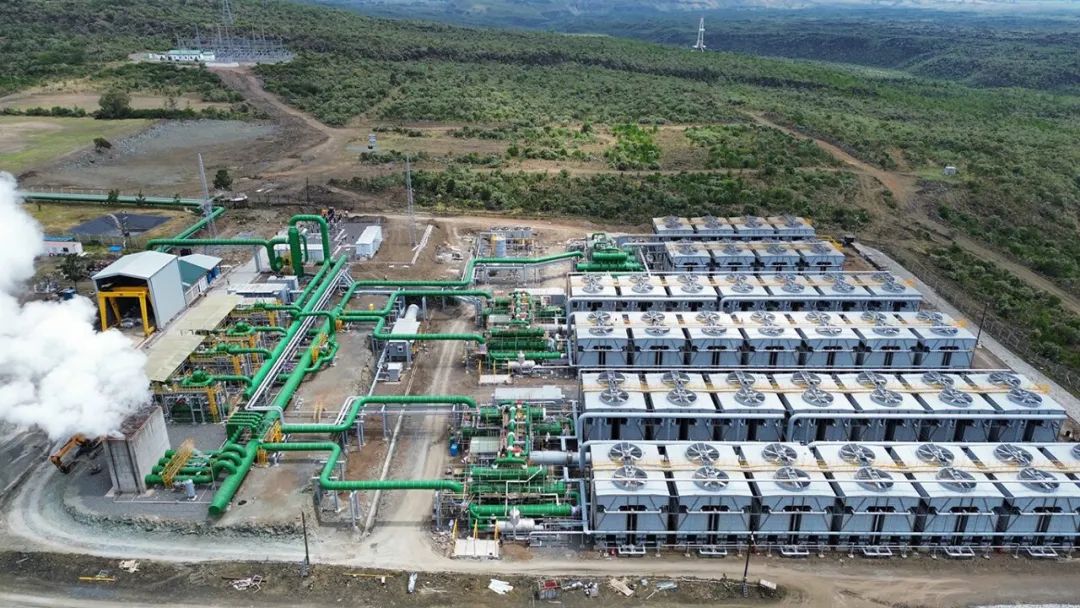
Sosian Menegai during the commissioning phase. Courtesy: Kaishan Group
Sosian Menengai Geothermal Power, Kenya’s newest geothermal power plant, is powered by modular technology that maximizes efficiency, reduces costs, and enhances scalability.
Kenya’s scenic Rift Valley region is a literal hotbed of geothermal potential. Part of the vast East African Rift Valley System (EARS), a 6,400-kilometer (km) tectonic divergence that is cleaving the African continent into two plates, Kenya’s Rift Valley forms a vertical corridor of intensive faulting and volcanic activity, hot springs, fumaroles, and sulfur-oozing fissures. But while the country began geothermal exploration for power development in the 1950s, most of its investments have been focused on the Olkaria region situated within Hell’s Gate National Park near the flamingo-flecked Lake Naivasha in Nakuru County. Five of six geothermal power stations in Olkaria are owned by KenGen (with a combined capacity of 799 MW), while Nevada-based Ormat Technologies owns a 150-MW plant. Olkaria plants in 2023 provided nearly 45% of Kenya’s total generation, a sizeable contribution to the East African powerhouse’s meager 3.3-GW installed capacity.
In 2008, the Geothermal Development Co. (GDC), a state-owned special-purpose vehicle tasked with accelerating the nation’s geothermal resource development, expanded its focus to the Menengai region just north of Olkaria, at the site of a massive shield volcano with one of the biggest calderas in the world. While GDC says the Menengai complex harbors a potential of 1,600 MW, its long-term goal is to develop 465 MW of geothermal steam equivalent.
In 2013, it took the first step to competitively award the first three initial 35-MW power projects at the complex to three independent power producers (IPPs): Orpower 22 (a former subsidiary of New York firm Symbion now owned by China’s Kaishan Group), South African-based Quantum Power East Africa (now majority owned by UK firm Globeleq), and Nairobi-headquartered Sosian Energy. In August 2023, the first of these projects—Menengai III, now formally known as the Sosian Menengai Geothermal Power—wrapped up a 16-month construction timeframe and began delivering first power to the grid.
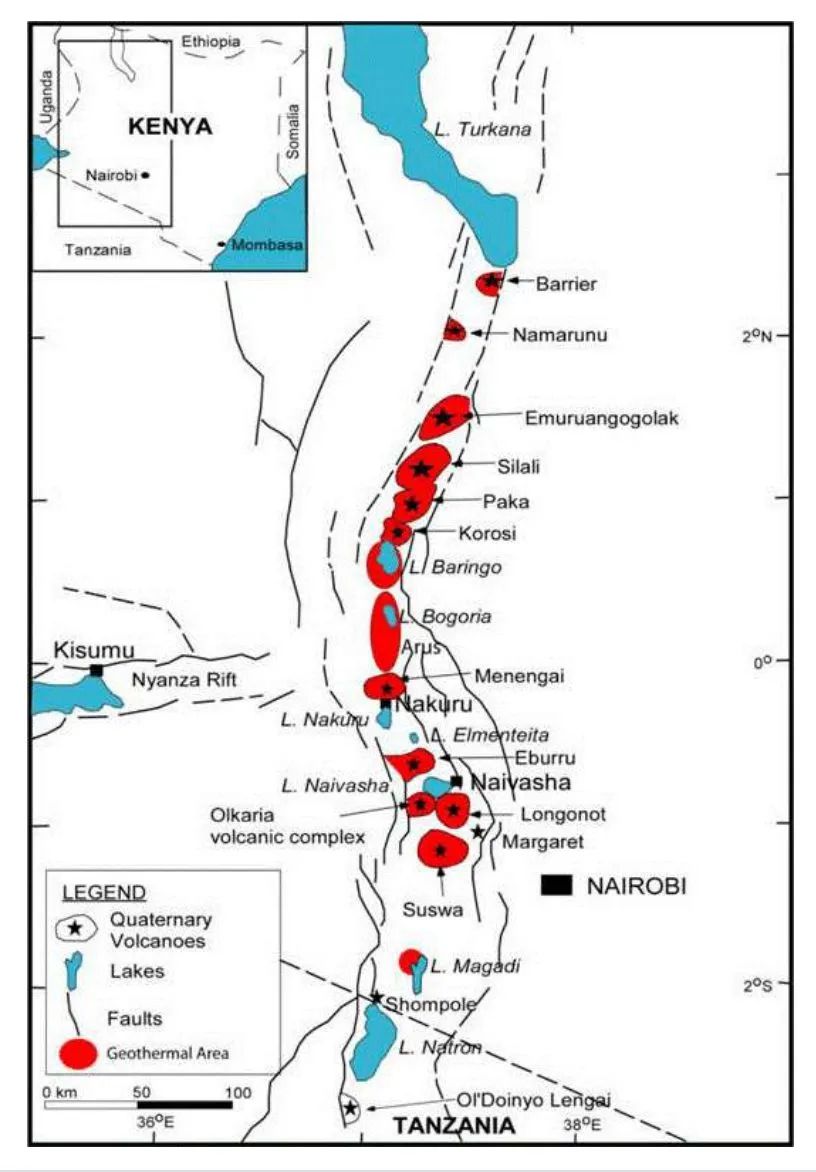
Map showing locations of geothermal area along the Kenyan Rift Valley. Courtesy: KenGen
A Technology Breakthrough
Sosian’s condensed timeframe is especially stunning given that traditional geothermal development can exceed seven years. This is owing in part to a complex process that involves drilling and testing multiple wells, selecting a centralized power plant locations, ordering steam turbines, and constructing extensive steam collection and reinjection systems. The traditional approach is also ridden with risks, including significant delays and inefficiencies, such as energy losses from steam pressure drops, thermal losses over long distances, and the underutilization of wells with varying pressures.
Sosian, to some measure, had the benefit of the GDC’s public-private partnership model for developing Menengai, under which the GDC assumes upfront risks of geothermal development. The state company has also notably set out to develop the field in five phases, starting with a 105-MW “steam sales” model, where it supplies steam from drilled wells to the power plants via a 25-km steam gathering and piping system. As of 2023, GDC had drilled 53 wells with a potential of 169 MW.
However, the power plant’s success can also be attributed to a distinctive new geothermal development process introduced by China’s Kaishan Group. Dr. Tang Yan, general manager of Kaishan Group, recalled realizing the need for a dramatic shift at a 2015 geothermal conference in Melbourne, Australia, where experts discussed the pitfalls of conventional methods. “I said, ‘Why don’t you put a power plant on the wellhead and do it phase by phase?’ ” he recounted.
Overcoming Traditional Challenges
While the approach proposed to support incremental power production from the start while providing revenue to support future project expansion, Yan learned no technology to support the approach was commercially available. Kaishan, which had then already begun its transition from a giant Shanghai-headquartered air compressor maker to a diversified global company, jumped into action to leverage its 2012-developed Organic Rankine Cycle (ORC) expander and screw steam expander technologies.
The technologies—originally developed for waste heat recovery from refineries and steel mills—allowed Kaishan to optimize geothermal power generation by maximizing energy output from varying well conditions, reducing inefficiencies, and enabling the development of four types of decentralized, modular power plants that are quicker to deploy and more adaptable to different geothermal fields, Yan told POWER. “These modular power plants include the steam screw expander modular power plants, the steam ORC modular power plants, the brine ORC modular power plants, and the steam and brine dual resource modular power plants,” he explained.
Steam screw expanders are specifically designed to handle wet or saturated steam, which is common in geothermal wells, effectively extracting energy from a wider range of well conditions, including wells with high non-condensable gas (NCG) content that may not be suitable for traditional turbines. ORC systems, meanwhile, are adept at converting lower-temperature steam and brine—byproducts that would otherwise go to waste—into additional electricity, Yan said.
In addition, Kaishan’s modular plants can be used to form hybrid cycles or thermal systems to meet any production well conditions, maximize their power output, and eliminate low-head pressure (WHP) wasted wells or idling wells. Because the technologies can be adapted to specific geothermal resource conditions at different project sites, they can be tailored to provide stellar efficiency, he said. “We can improve the well thermal efficiency of, for example, medium enthalpy wells, to up to 18% and 19%,” he said. That compares to only 8% to 12% for traditional centralized power plants that only use single-flash steam, he noted.
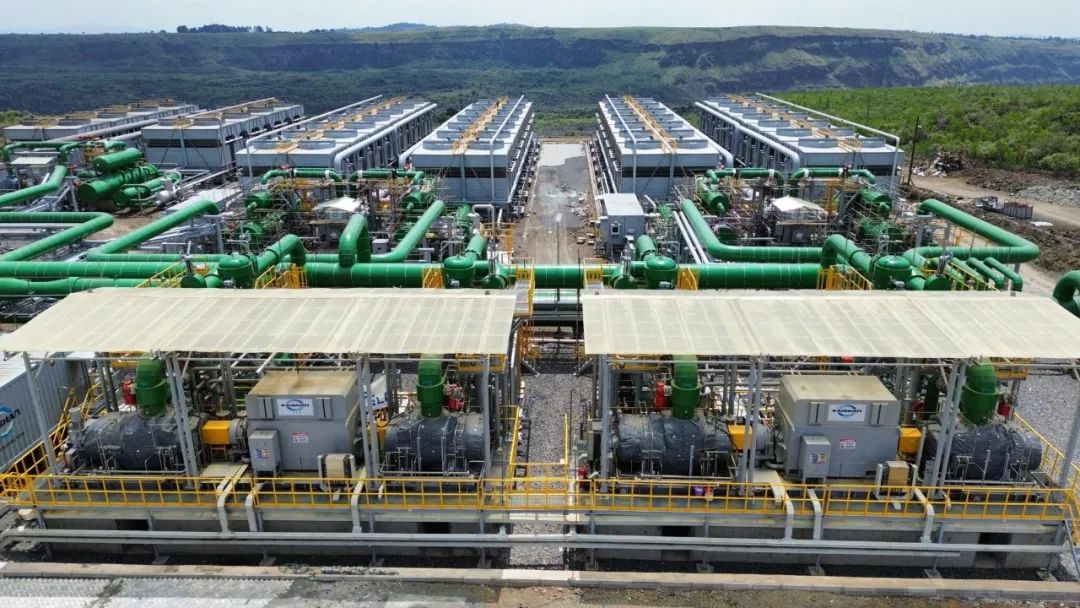
he 35-MWe Sosian Menengai Geothermal Power plant was commissioned in August 2023. The plant uses two Kaishan geothermal steam counterpressure screw expanders, which discharge their exhausts into three Organic Rankine Cycle units. Courtesy: Kaishan Group
A Competitive Edge for New Geothermal Power
Kaishan quickly expanded the niche technology into a lucrative business. Since it put online the first of four phases of the 240-MW Sorik Marapi Geothermal Project in Indonesia in 2018, it has built the 10-MW Sokoria Geothermal, also in Indonesia, alongside projects in Turkey, the U.S., and Hungary. At Sosian, Kaishan’s first project in Kenya, the company served as the engineering, procurement, and construction (EPC) contractor.
According to Yan, Kaishan’s cost-effective price point proved a crucial selection advantage. Kaishan’s EPC contract is valued at $65 million, compared to a $108 million EPC contract recently awarded for Menengai II, one of the region’s three equally sized IPP projects. The price difference is rooted in the technology selection, Yan explained. While Sosian’s 35-MW project was designed as a centralized power plant, it is powered by two steam screw expanders and three wet steam ORC modular power plants.
However, GDC’s steam contains 3.3% NCG—which represents a “huge percentage,” he said. If Sosian used traditional steam turbines, they would need to expand steam at 6 bar absolute and then consume more then 30 tons of steam per hour to remove NCG using steam injectors and vacuum pumps. Instead, Sosian employs steam screw expanders and a bottom cycle to handle the saturated steam discharge, reducing the steam to atmospheric levels throughout the entire process while eliminating the parasitic power typically consumed by vacuum systems.
“The overall efficiency compared to a traditional steam turbine is a huge game changer for this site,” Yan said. “The project only needed a guarantee of 33.25 MW, and the target was 35 MW, but we’re actually generating 37 MW.” At the same time, the project doesn’t need to purchase the extra 10% of steam for a steam injector, putting less of a burden on the GDC, he said.
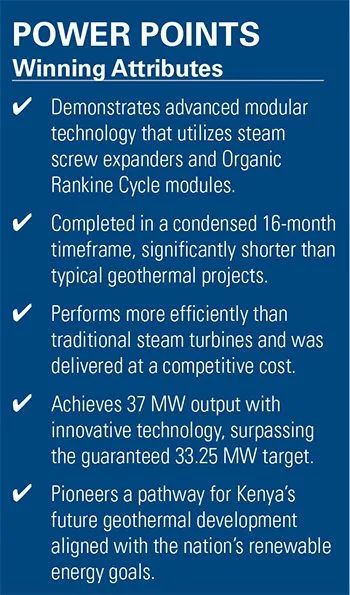
A Solution for Idled Wells
The modularity of the system also proved beneficial to speed up construction and, crucially, to overcome supply chain and project management challenges posed by the COVID pandemic, Yan said. Kaishan typically assembles the modules and conducts component testing in a factory setting over six to nine months, he said. “And then, when we ship to the site, usually it takes a very short time to put them together, and you don’t need to do any welding on the power modules,” he added. “That’s sometimes where quality control can be a challenge,” he noted.
The success of the Sosian Menegai project has so far sparked significant interest in Kenya’s geothermal industry, Yan said. A key reason is that Kenya has a lot of wells, and an estimated 25% to 30% of those wells may not be supported by a steam collection system, which is needed by centralized steam turbines. “They call them idled wells or wasted wells, and they sit there and do nothing,” even if it was costly to drill them, he said. “But our technology doesn’t have that limitation because we can use any good pressure, whether they can produce brine or steam.”
—Sonal Patel is a POWER senior editor (@sonalcpatel, @POWERmagazine).
中文(wén)翻譯(yì)稿
模塊化發電廠正在提(tí)高肯尼亞地熱效(xiào)率
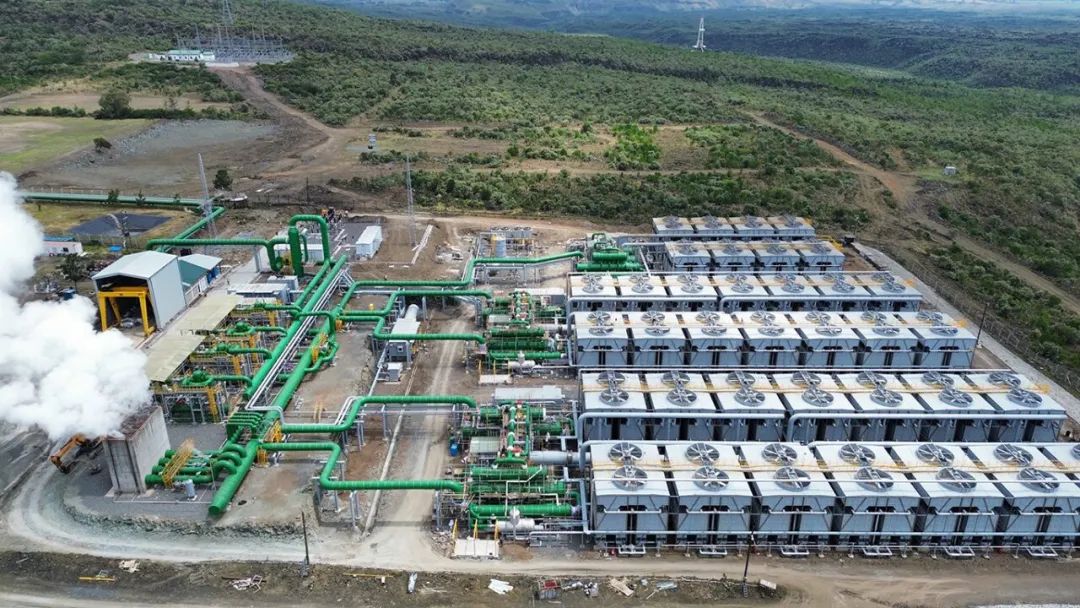
調試階段的 Sosian Menegai。圖片(piàn)來(lái)源:午夜免费视频集團
肯尼亞最新的地熱(rè)發電廠(chǎng) Sosian Menengai 地熱發電(diàn)廠(chǎng)采用模塊化技術,可最大限度提高效率、降低成本並(bìng)增強可擴展性。
肯尼亞風景秀麗的裂穀地區是地(dì)熱資源的寶(bǎo)庫。肯尼亞裂穀是廣闊(kuò)的東非(fēi)大裂穀(gǔ)係統 (EARS) 的一(yī)部分,東非大(dà)裂穀係統是(shì)一個長達 6,400 公裏的地質(zhì)構造分叉,將非洲大陸一分為二。肯尼亞裂穀形成了一個垂直走廊,其中(zhōng)有密集的斷層和火山活動、溫泉、噴氣孔和(hé)硫磺滲出的裂縫。盡管肯尼亞在 20 世紀 50 年代(dài)就(jiù)開始進行(háng)地熱勘探以開發電力,但其大部分(fèn)投資都集中(zhōng)在位於(yú)地獄之門國家公園內的奧爾卡裏亞地區,該公園靠近納(nà)庫魯(lǔ)縣火烈鳥(niǎo)點綴的納瓦沙湖。奧(ào)爾卡裏亞的六座地熱發電站中有五座歸 KenGen 所有(yǒu)(總容(róng)量為 799 兆瓦),而總部位於內華(huá)達州(zhōu)的 Ormat Technologies擁有一(yī)座 150 兆瓦的發電站。到 2023 年,奧爾卡裏亞 (Olkaria) 電廠將提供肯(kěn)尼亞(yà)近 45% 的總發電量(liàng),為這個東非強國僅有的 3.3 吉瓦的裝機容量做出(chū)了巨大貢獻。
2008 年,地熱開發公司(sī) (GDC) 將重點擴大到奧爾卡裏亞以北的梅嫩蓋地區,該地區是一座巨大的盾形(xíng)火山,擁有世界上最大的火山口之一。地(dì)熱開發(fā)公司是一家國有特殊目的公司(sī),其任務是加速該國的地(dì)熱資源開發。GDC 表示,梅嫩蓋綜合體蘊藏著 1,600 兆瓦的地熱潛力,但其長期目標是開發 465 兆瓦的地熱蒸汽當量。
2013 年,該集團邁出了第一步(bù),通(tōng)過競(jìng)爭方式將該綜合體中的前三個 35 兆瓦發(fā)電項目授予三(sān)家獨立電力供應商 (IPP):Orpower 22(前身為紐約(yuē) Symbion 公司的子公司,現(xiàn)歸中國午夜免费视频集團所有)、總部(bù)位於南非的 Quantum Power East Africa(現(xiàn)由英國公司 Globeleq 控股)和總部位於內羅畢的 Sosian Energy。2023 年 8 月,這些項目中的(de)第一個項目——Menengai III(現正式稱為 Sosian Menengai 地熱發電項目)結束了為期 16 個月的(de)建設工期,並開始向電網輸送第一批(pī)電(diàn)力。
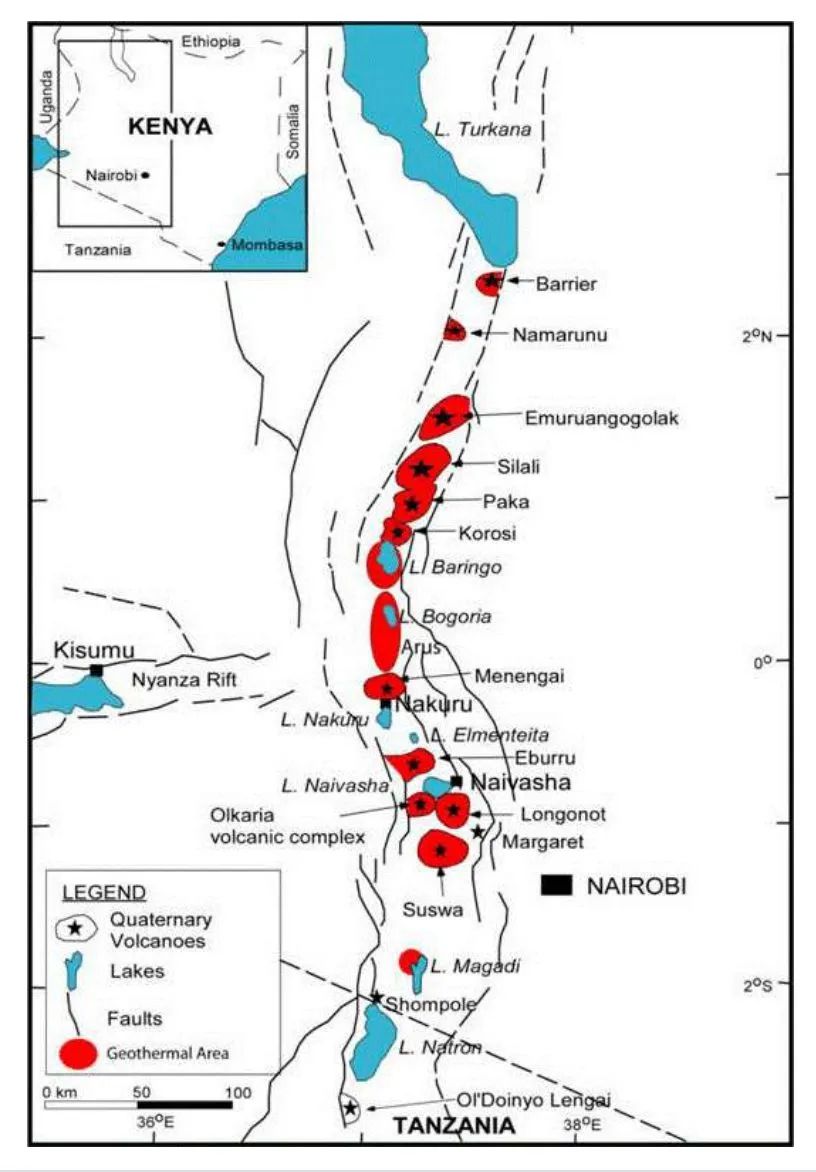
地圖顯示了肯尼亞(yà)裂穀沿線地熱區(qū)的位置。圖片來源:KenGen
技術突破
鑒於傳統地熱開發可能要耗(hào)時超過七年,Sosian 的縮短工期(qī)尤其令人震驚。這(zhè)在一定(dìng)程度上歸因於一個複(fù)雜的過程(chéng),包括鑽探和測試(shì)多個井、選擇集中發(fā)電廠位置、訂購蒸汽渦輪機以及建造廣泛的蒸汽(qì)收集和再注入係統。傳統方法也(yě)充滿(mǎn)風險,包括嚴重的延誤和效率(lǜ)低(dī)下,例如蒸汽壓力下(xià)降(jiàng)造成的能量損失、長距離熱(rè)損失以及壓力變化的井的利用不足。
在某種程度上,Sosian 受(shòu)益於 GDC 開發 Menengai 的公私合作(zuò)模式,根(gēn)據該模式,GDC 承擔地熱(rè)開發的前期風險(xiǎn)。值得注意的(de)是,這家國有公(gōng)司還計(jì)劃分五個階段開發該地熱田(tián),首先采(cǎi)用 105 兆瓦的“蒸汽銷售”模(mó)式,通過 25 公裏長的蒸汽收集和管道係統將鑽井中(zhōng)的(de)蒸(zhēng)汽供(gòng)應給發電廠。截(jié)至 2023 年,GDC 已鑽(zuàn)探了 53 口井,潛力為 169 兆(zhào)瓦。
然而,該發電廠的成功也歸(guī)功於中國午夜免费视频集團推出的獨特的新型地熱開發工藝。午夜免费视频(shān)集團總經理湯炎博士回憶說,他(tā)在 2015 年澳大利亞墨爾(ěr)本舉行的地熱會議(yì)上意(yì)識到需要進行重大轉變,當時專(zhuān)家們討論了(le)傳統方法的缺陷。“我說,‘你為什麽不在井口建一個發電廠(chǎng),分階(jiē)段進行呢?’”他回憶道。
克服傳統挑戰
雖然該方法(fǎ)從一開(kāi)始(shǐ)就提出支持增(zēng)量發電,同時提供收(shōu)入以支持未來的項目(mù)擴展,但湯炎博士了解到,沒(méi)有支持該方法的技術可供商業使用。午夜免费视频當時已經開始從一家總部位於(yú)上海(hǎi)的大型空氣(qì)壓縮機製造商轉型為一家多(duō)元化的全球性公司(sī),並立即采取行動,利用其 2012 年開發的有機朗肯循環 (ORC) 膨脹機和螺杆蒸汽膨脹機技術。
湯炎博(bó)士告訴《POWER》雜誌,這些技術最初是為回收煉油廠和鋼廠的廢熱(rè)而開發的,它使午夜免费视频公司能夠(gòu)通過最大限度地(dì)提高不同井況下的能量輸出、減少低效率,以及開發四種類型的分散式模塊化發電廠來優化地熱(rè)發電,這些(xiē)發電廠部署速(sù)度更快,更能適應不同的地熱田。 “這些模塊化發電廠包括蒸(zhēng)汽螺杆膨脹機模塊化發電廠、蒸(zhēng)汽 ORC 模塊化發電廠、鹽水 ORC 模塊化發電廠以及蒸汽和(hé)鹽水(shuǐ)雙資源模塊化發電廠,”他解釋說。
蒸汽螺杆(gǎn)膨脹機專門設計用於處理地熱井中常見的濕蒸汽或飽和蒸汽,可有效從各種井況中提取能量,包括可能(néng)不(bú)適(shì)合傳統渦輪(lún)機的不凝性氣體 (NCG)含(hán)量高的井。與此同時(shí),ORC 係統(tǒng)擅長將低溫蒸(zhēng)汽和鹽水(否則這些副產品將被浪費)轉化為額外的電能,湯炎博士說。
此外,開(kāi)山的模塊化電廠可用於形成混合循環或熱力係統,以滿足任何生產井條件,最大限度地提高其發(fā)電量,並消除低壓 (WHP) 浪費井或閑置井。他說,由於這些技術可以適應不同項目地點(diǎn)的特定地熱資源條件(jiàn),因此可以量身定(dìng)製以提供卓越的效率。他說(shuō):“我們可以將中焓井的熱效(xiào)率提(tí)高到 18% 和(hé) 19%。”他(tā)指出,相比之下,僅使用單次閃蒸蒸汽的傳統集中式發電廠的熱效率僅為 8% 至 12%。
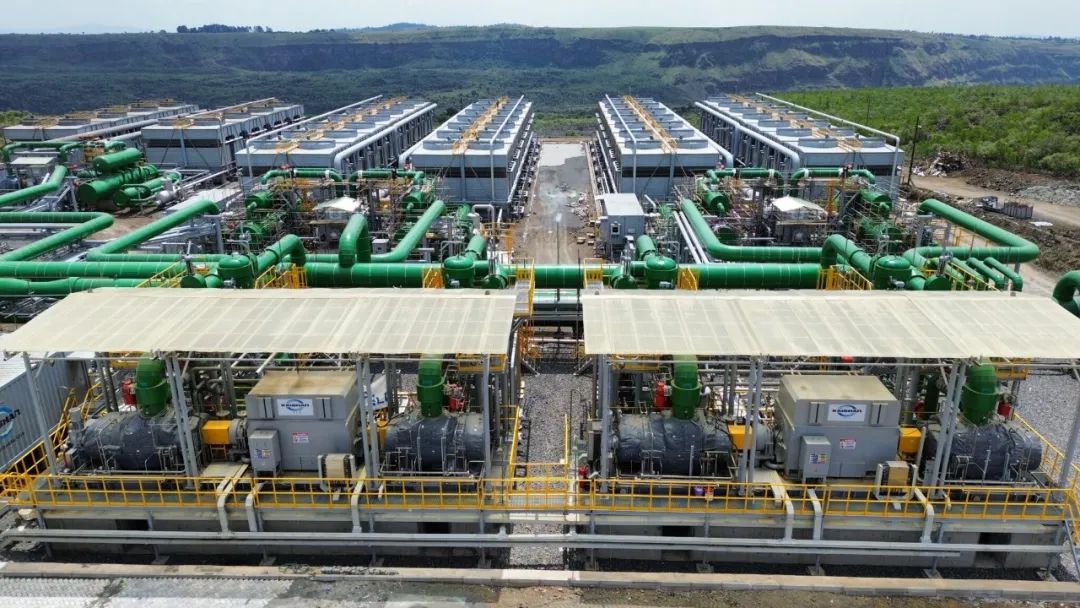
35 MWe 的 Sosian Menengai 地熱發電廠於 2023 年 8 月投入(rù)使用。該電廠使用兩台午夜免费视频地熱蒸(zhēng)汽反壓螺杆膨脹機(jī),將廢氣排放到三個有機(jī)朗肯循環裝置(zhì)中。圖片來源:午夜免费视频集團
新地熱發電(diàn)的競爭優勢
午夜免费视频迅速將(jiāng)這項小眾技(jì)術拓展為一項利潤豐厚的業務。自2018 年在印(yìn)度尼西亞投產 240 兆瓦 Sorik Marapi 地(dì)熱項目四期(qī)工程中的第一期以來,該(gāi)公司已在印度(dù)尼西亞建造了 10 兆瓦的(de) Sokoria 地熱項目,此(cǐ)外還在土耳其、美國和匈牙利開展了項(xiàng)目。Sosian是午夜免费视频在(zài)肯尼亞的第(dì)一個地熱項目,公司擔任工程、采購和施工 (EPC) 承包商。
湯炎博士表示,開(kāi)山電廠具有成本效益的價格點是其關鍵(jiàn)的選擇優勢。午夜免费视频電廠的 EPC 合同價值 6500 萬(wàn)美元,而該地區三個同(tóng)等規(guī)模的 IPP 項目之一 Menengai II 最近獲得的 EPC 合同價值 1.08 億美元(yuán)。湯炎博士解釋說,價格差異(yì)的根源在於技術選擇。雖然 Sosian 的 35 兆瓦項(xiàng)目設計為集中式發電廠,但它由兩個蒸汽螺杆膨脹機和三個濕蒸汽 ORC 模塊化發電(diàn)廠提供動力。
然而,GDC 的蒸汽含有(yǒu) 3.3% 的 NCG,這是一個“巨大的百分(fèn)比”,他說。如果 Sosian 使用傳統的(de)蒸汽(qì)輪(lún)機,他們需要將蒸汽膨脹至 6 bar 絕對壓(yā)力,然後每小時消耗超過 30 噸的蒸汽,使用蒸汽噴射器和(hé)真空泵(bèng)去(qù)除 NCG。相反,Sosian 使用蒸(zhēng)汽螺杆膨脹機和(hé)底部循環來處理(lǐ)飽和蒸(zhēng)汽排放,在整個過(guò)程中將蒸汽降低到大氣水平,同時消(xiāo)除真空係統通常消(xiāo)耗的寄生功率。
“與傳統蒸汽輪(lún)機(jī)相(xiàng)比,整體效率對於該站點來說是一個巨大的改變(biàn),”湯炎博士說道。“該項目隻需(xū)要保(bǎo)證(zhèng) 33.25 兆瓦,目標是 35 兆瓦,但我們實際上發電量為 37 兆瓦。”同時,該項目不需要額外購買10%的(de)蒸汽用於蒸汽噴(pēn)射器,從而減輕了GDC的負擔,他說。
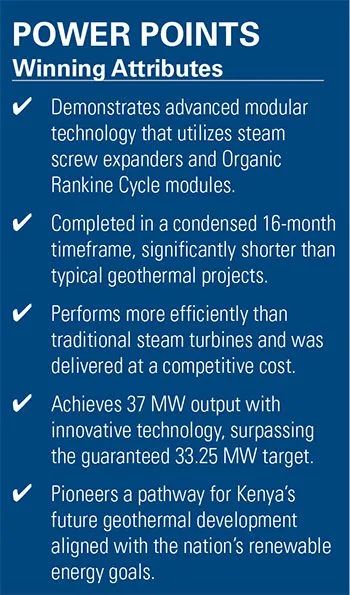
閑置地熱井(jǐng)的解決方案
湯炎博士表示,該係統的模塊(kuài)化設計(jì)也有利於加快施(shī)工速度,更重(chóng)要的是,有(yǒu)助於克服新冠疫情帶來的供應(yīng)鏈和項目管理挑戰。他(tā)說,午夜免费视频通常會在六到九(jiǔ)個月的時間內組裝模塊並在工(gōng)廠環境中進行組件測試。“然後,當我們運送到現(xiàn)場時,通常隻需(xū)很(hěn)短的時(shí)間即可將它們組裝在一起,並且您無(wú)需對電源模塊進行任(rèn)何焊接,”他補充道。“有時,質量控製可能是一個挑戰,”他指(zhǐ)出。
他還說,Sosian Menegai 項目的成功迄今已引起人們對肯尼亞(yà)地熱產業的極大興趣。一個關(guān)鍵原因是肯尼亞有很多井,估計其中 25% 到(dào) 30% 的井可能沒有蒸汽(qì)收集(jí)係統,而蒸(zhēng)汽收集係統是集中式蒸汽渦輪機所必需的。“他(tā)們稱這些(xiē)井為閑置井或廢(fèi)棄井,它(tā)們就(jiù)放在那裏,什麽也不做”,即使鑽探這些井的(de)成本很高,“但我們的技術沒有這種限製,因(yīn)為我們可以使用任何良好的壓力,無論它們是產生鹽水還是蒸汽。”
— Sonal Patel 是 POWER 的高級編輯(@sonalcpatel, @POWERmagazine)
